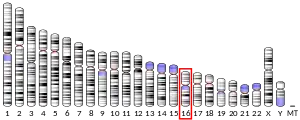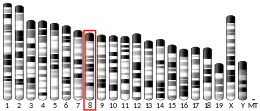VAC14
Protein VAC14 homolog, also known as ArPIKfyve (Associated Regulator of PIKfyve), is a protein that in humans is encoded by the VAC14 gene.[5][6][7]
| VAC14 | |||||||||||||||||||||||||||||||||||||||||||||||||||
|---|---|---|---|---|---|---|---|---|---|---|---|---|---|---|---|---|---|---|---|---|---|---|---|---|---|---|---|---|---|---|---|---|---|---|---|---|---|---|---|---|---|---|---|---|---|---|---|---|---|---|---|
| Identifiers | |||||||||||||||||||||||||||||||||||||||||||||||||||
| Aliases | VAC14, ArPIKfyve, TAX1BP2, TRX, Vac14, PIKFYVE complex component, VAC14 component of PIKFYVE complex | ||||||||||||||||||||||||||||||||||||||||||||||||||
| External IDs | OMIM: 604632 MGI: 2157980 HomoloGene: 6528 GeneCards: VAC14 | ||||||||||||||||||||||||||||||||||||||||||||||||||
| |||||||||||||||||||||||||||||||||||||||||||||||||||
| |||||||||||||||||||||||||||||||||||||||||||||||||||
| |||||||||||||||||||||||||||||||||||||||||||||||||||
| |||||||||||||||||||||||||||||||||||||||||||||||||||
| |||||||||||||||||||||||||||||||||||||||||||||||||||
| Wikidata | |||||||||||||||||||||||||||||||||||||||||||||||||||
| |||||||||||||||||||||||||||||||||||||||||||||||||||
Function
The content of phosphatidylinositol 3,5-bisphosphate (PtdIns(3,5)P2) in endosomal membranes changes dynamically with fission and fusion events that generate or absorb intracellular transport vesicles. The ArPIKfyve protein scaffolds a trimolecular complex to tightly regulate the level of PtdIns(3,5)P2. Other components of this complex are the PtdIns(3,5)P2-synthesizing enzyme PIKFYVE and the Sac1-domain-containing PtdIns(3,5)P2 5-phosphatase Sac3, encoded by the human gene FIG4. VAC14 functions as an activator of PIKFYVE.[5][8] Studies in VAC14 knockout mice indicate that, in addition to increasing the PtdIns(3,5)P2-producing activity of PIKfyve, VAC14 also controls the steady-state levels of another rare phosphoinositide linked to PIKfyve enzyme activity – phosphatidylinositol 5-phosphate. It is seen that VAC14 is scaffold protein that acts in complex with the lipid kinase PIKfyve which works to phosphorylate phosphatidylinositol-3-phosphate, as well as the counteracting phosphatase FIG4, which removes a phosphate group.[9]
In addition to the formation of the ternary complex with PIKfyve and Sac3, ArPIKfyve is engaged in a number of other interactions. ArPIKfyve forms a stable complex with the PtdIns(3,5)P2-specific phosphatase Sac3, thereby protecting Sac3 from rapid degradation in the proteasome.[10] ArPIKfyve forms a homooligomer through its carboxyl terminus. However, the number of monomers in the ArPIKfyve homooligomer, ArPIKfyve-Sac3 heterodimer or PIKfyve-ArPIKfyve-Sac3 heterotrimer is unknown.[11] Human Vac14/ArPIKfyve also interacts with the PDZ (post-synaptic density) domain of neuronal nitric oxide synthase [12] but the functional significance of this interaction is still unclear. ArPIKfyve facilitates insulin-regulated GLUT4 translocation to the cell surface.[13]
Mouse models
VAC14 knock-out mice die at, or shortly after birth and exhibit massive neurodegeneration. Fibroblasts from these mice display ~50% lower levels of PtdIns(3,5)P2 and PtdIns(5)P.[14] A spontaneous mouse VAC14-point mutation (with arginine substitution of leucine156) is associated with reduced life span (up to 3 weeks), body size, enlarged brain ventricles, 50% decrease in PtdIns(3,5)P2 levels, diluted pigmentation, tremor and impaired motor function.[15]
Clinical significance
The VAC14 gene has been linked to human disease.[16] It is thought that the PIKfyve-VAC14-FIG4 complex plays an important role on the maturation of early endosomes to late endosomes/lysosomes. These organelles play critical roles in vesicular trafficking, which move cargo from donor membrane cells to target membranes within the body.[17]
References
- GRCh38: Ensembl release 89: ENSG00000103043 - Ensembl, May 2017
- GRCm38: Ensembl release 89: ENSMUSG00000010936 - Ensembl, May 2017
- "Human PubMed Reference:". National Center for Biotechnology Information, U.S. National Library of Medicine.
- "Mouse PubMed Reference:". National Center for Biotechnology Information, U.S. National Library of Medicine.
- "Entrez Gene: Vac14 homolog (S. cerevisiae)".
- Davy BE, Robinson ML (May 2003). "Congenital hydrocephalus in hy3 mice is caused by a frameshift mutation in Hydin, a large novel gene". Human Molecular Genetics. 12 (10): 1163–1170. doi:10.1093/hmg/ddg122. PMID 12719380.
- Sbrissa D, Ikonomov OC, Strakova J, Dondapati R, Mlak K, Deeb R, et al. (December 2004). "A mammalian ortholog of Saccharomyces cerevisiae Vac14 that associates with and up-regulates PIKfyve phosphoinositide 5-kinase activity". Molecular and Cellular Biology. 24 (23): 10437–10447. doi:10.1128/MCB.24.23.10437-10447.2004. PMC 529046. PMID 15542851.
- Sbrissa D, Ikonomov OC, Fu Z, Ijuin T, Gruenberg J, Takenawa T, Shisheva A (August 2007). "Core protein machinery for mammalian phosphatidylinositol 3,5-bisphosphate synthesis and turnover that regulates the progression of endosomal transport. Novel Sac phosphatase joins the ArPIKfyve-PIKfyve complex". The Journal of Biological Chemistry. 282 (33): 23878–23891. doi:10.1074/jbc.M611678200. PMID 17556371.
- Schulze U, Vollenbröker B, Braun DA, Van Le T, Granado D, Kremerskothen J, et al. (June 2014). "The Vac14-interaction network is linked to regulators of the endolysosomal and autophagic pathway". Molecular & Cellular Proteomics. 13 (6): 1397–1411. doi:10.1074/mcp.M113.034108. PMC 4047462. PMID 24578385.
- Ikonomov OC, Sbrissa D, Fligger J, Delvecchio K, Shisheva A (August 2010). "ArPIKfyve regulates Sac3 protein abundance and turnover: disruption of the mechanism by Sac3I41T mutation causing Charcot-Marie-Tooth 4J disorder". The Journal of Biological Chemistry. 285 (35): 26760–26764. doi:10.1074/jbc.C110.154658. PMC 2930674. PMID 20630877.
- Sbrissa D, Ikonomov OC, Fenner H, Shisheva A (December 2008). "ArPIKfyve homomeric and heteromeric interactions scaffold PIKfyve and Sac3 in a complex to promote PIKfyve activity and functionality". Journal of Molecular Biology. 384 (4): 766–779. doi:10.1016/j.jmb.2008.10.009. PMC 2756758. PMID 18950639.
- Lemaire JF, McPherson PS (December 2006). "Binding of Vac14 to neuronal nitric oxide synthase: Characterisation of a new internal PDZ-recognition motif". FEBS Letters. 580 (30): 6948–6954. doi:10.1016/j.febslet.2006.11.061. PMID 17161399. S2CID 40346432.
- Ikonomov OC, Sbrissa D, Dondapati R, Shisheva A (July 2007). "ArPIKfyve-PIKfyve interaction and role in insulin-regulated GLUT4 translocation and glucose transport in 3T3-L1 adipocytes". Experimental Cell Research. 313 (11): 2404–2416. doi:10.1016/j.yexcr.2007.03.024. PMC 2475679. PMID 17475247.
- Zhang Y, Zolov SN, Chow CY, Slutsky SG, Richardson SC, Piper RC, et al. (October 2007). "Loss of Vac14, a regulator of the signaling lipid phosphatidylinositol 3,5-bisphosphate, results in neurodegeneration in mice". Proceedings of the National Academy of Sciences of the United States of America. 104 (44): 17518–17523. Bibcode:2007PNAS..10417518Z. doi:10.1073/pnas.0702275104. PMC 2077288. PMID 17956977.
- Jin N, Chow CY, Liu L, Zolov SN, Bronson R, Davisson M, et al. (December 2008). "VAC14 nucleates a protein complex essential for the acute interconversion of PI3P and PI(3,5)P(2) in yeast and mouse". The EMBO Journal. 27 (24): 3221–3234. doi:10.1038/emboj.2008.248. PMC 2600653. PMID 19037259.
- Lenk GM, Szymanska K, Debska-Vielhaber G, Rydzanicz M, Walczak A, Bekiesinska-Figatowska M, et al. (July 2016). "Biallelic Mutations of VAC14 in Pediatric-Onset Neurological Disease". American Journal of Human Genetics. 99 (1): 188–194. doi:10.1016/j.ajhg.2016.05.008. PMC 5005439. PMID 27292112.
- Qiu S, Lavallée-Adam M, Côté M (November 2021). "Proximity Interactome Map of the Vac14-Fig4 Complex Using BioID". Journal of Proteome Research. 20 (11): 4959–4973. doi:10.1021/acs.jproteome.1c00408. PMID 34554760. S2CID 237615479.
Further reading
- Mireskandari A, Reid RL, Kashanchi F, Dittmer J, Li WB, Brady JN (April 1996). "Isolation of a cDNA clone, TRX encoding a human T-cell lymphotrophic virus type-I Tax1 binding protein". Biochimica et Biophysica Acta (BBA) - Gene Structure and Expression. 1306 (1): 9–13. doi:10.1016/0167-4781(96)00012-7. PMID 8611628.



